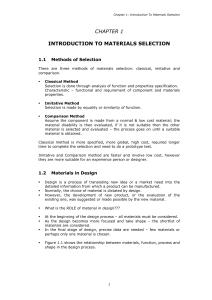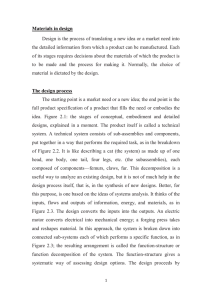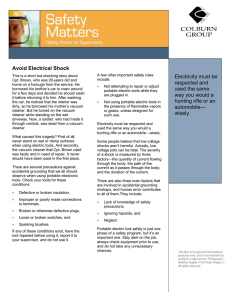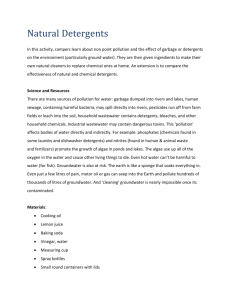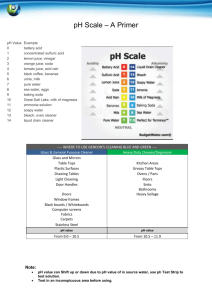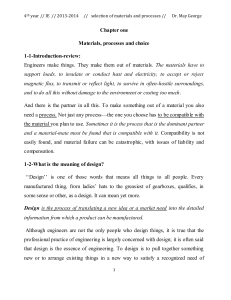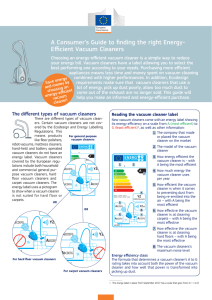Design is the process of translating a new idea or... detailed information from which a product can be manufactured. Each...
advertisement
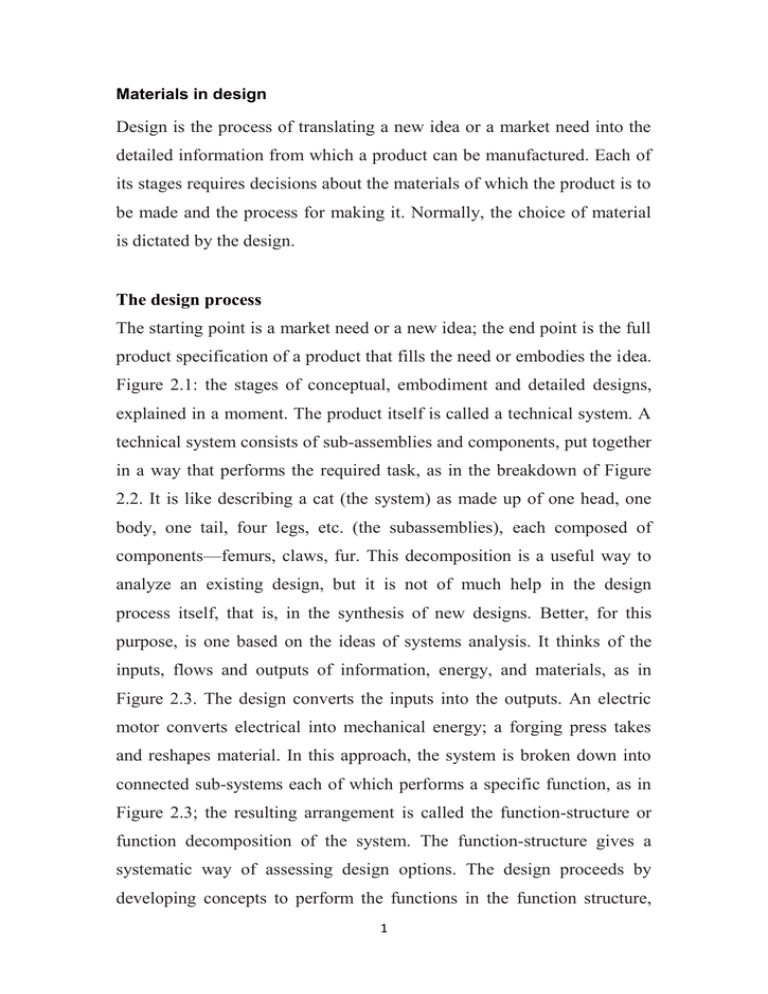
Materials in design Design is the process of translating a new idea or a market need into the detailed information from which a product can be manufactured. Each of its stages requires decisions about the materials of which the product is to be made and the process for making it. Normally, the choice of material is dictated by the design. The design process The starting point is a market need or a new idea; the end point is the full product specification of a product that fills the need or embodies the idea. Figure 2.1: the stages of conceptual, embodiment and detailed designs, explained in a moment. The product itself is called a technical system. A technical system consists of sub-assemblies and components, put together in a way that performs the required task, as in the breakdown of Figure 2.2. It is like describing a cat (the system) as made up of one head, one body, one tail, four legs, etc. (the subassemblies), each composed of components—femurs, claws, fur. This decomposition is a useful way to analyze an existing design, but it is not of much help in the design process itself, that is, in the synthesis of new designs. Better, for this purpose, is one based on the ideas of systems analysis. It thinks of the inputs, flows and outputs of information, energy, and materials, as in Figure 2.3. The design converts the inputs into the outputs. An electric motor converts electrical into mechanical energy; a forging press takes and reshapes material. In this approach, the system is broken down into connected sub-systems each of which performs a specific function, as in Figure 2.3; the resulting arrangement is called the function-structure or function decomposition of the system. The function-structure gives a systematic way of assessing design options. The design proceeds by developing concepts to perform the functions in the function structure, 1 each based on a working principle. At this, the conceptual design stage, all options are open: the designer considers alternative concepts and the ways in which these might be separated or combined. The next stage, embodiment, takes the promising concepts and seeks to analyze their operation at an approximate level. This involves sizing the components, and selecting materials that will perform properly in the ranges of stress, temperature, and environment suggested by the design requirements, examining the implications for performance and cost. The embodiment stage ends with a feasible layout, which is then passed to the detailed design stage. Types of design 1- Adaptive or developmental design takes an existing concept and seeks an incremental advance in performance through a refinement of the working principle. This, too, is often made possible by developments in materials: polymers replacing metals in household appliances; carbon fiber replacing wood in sports goods. The appliance and the sports-goods market are both large and competitive.Markets here have frequently been won (and lost) by the way in which the manufacturer has adapted the product by exploiting new materials. 2- Variant design involves a change of scale or dimension or detailing without change of function or the method of achieving it: the scaling up of boilers, or of pressure vessels, or of turbines, for instance. Change of scale or circumstances of use may require change of material: small boats are made of fiberglass, large ships are made of steel; small boilers are made of copper, large ones of steel; 2 3 Design tools and materials data design tools are shown as inputs, attached to the left of the main backbone of the design methodology in Figure 2.5. The tools enable the modeling and optimization of a design, easing the routine aspects of each phase. Function-modelers suggest viable function structures. Configuration optimizers suggest or refine shapes. Materials selection enters each stage of the design. The nature of the data needed in the early stages differs greatly in its level of precision and breadth from that needed later on (Figure 2.5, right-hand side). At the concept-stage, the designer requires approximate property-values, but for the widest possible range of materials. All options are open: a polymer may be the best choice for one concept, a metal for another, even though the function is the same. The problem, at this stage, is not precision and detail; it is breadth and speed of access: how can the vast range of data be presented to give the designer the greatest freedom in considering alternatives? At the embodiment stage the landscape has narrowed. Here 4 we need data for a subset of materials, but at a higher level of precision and detail. These are found in the more specialized handbooks and software that deal with a single class or sub-class of materials—metals, or just aluminum alloys, for instance. The final stage of detailed design requires a still higher level of precision and detail, but for only one or a very few materials. Such information is best found in the data-sheets issued by the material producers themselves, and in detailed databases for restricted material classes. A given material (polyethylene, for instance) has a range of properties that derive from differences in the ways different producers make it. At the detailed design stage, a supplier must be identified, and the properties of his product used in the design calculations; that from another supplier may have slightly different properties. 5 Function, material, shape, and process The selection of a material and process cannot be separated from the choice of shape. We use the word ‘‘shape’’ to include the external, macro-shape, and— when necessary—the internal, or micro-shape, as in cellular structure. To make the shape, the material is subjected to processes that, collectively, we shall call manufacture: they include primary forming processes (like casting and forging), material removal processes (machining, drilling), finishing processes (such as polishing) and joining processes (e.g. welding). Function, material, shape and process interact (Figure 2.6). Function dictates the choice of both material and shape. Process is influenced by the material: by its formability, machinability, weldability, heat-treatability, and so on. Process obviously interacts with shape—the process determines the shape, the size, the precision and, of course, the cost. The interactions are two-way: specification of shape restricts the choice of material and process; but equally the specification of process limits the materials you can use and the shapes theymcan take. The interaction between function, material, shape, and process lies at the heart of the material selection process. 6 Design methodology Figure 27.1 summarises the methodology for designing a component which must carry load. At the start there are two parallel streams: materials selection and component design. A tentative material is chosen and data for it are assembled from data sheets. At the same time, a tentative component design is drawn up, able to fill the function (which must be carefully defined at the start); and an approximate stress analysis is carried out to assess the stresses, moments, and stress concentrations to which it will be subjected. The two streams merge in an assessment of the material performance in the tentative design. If the material can bear the loads, moments, concentrated stresses (etc.) without deflecting too much, collapsing or failing in some other way, then the design can proceed. If the material cannot perform adequately, the first iteration takes place: either a new material is chosen, or the component design is changed (or both) to overcome the failing. The next step is a detailed specification of the design and of the material. This may require a detailed stress analysis, analysis of the dynamics of the system, its response to temperature and environment, and a detailed consideration of the appearance and feel (the aesthetics of the product). And it will require better material data: at this point it may be necessary tests yourself. The design is viable only if it can be produced economically. The choice of production and fabrication method is largely determined by the choice of material. But the production route will also be influenced by the size of the production run, and how the component will be finished and joined to other components; each class of material has its own special problems here; The choice of material and production route will, ultimately, determine the price of the product, so a second major iteration may be required if the costing shows the price to be too 7 high. Then a new choice of material or component design, allowing an alternative production path, may have to be considered. At this stage a prototype product is produced, and its performance in the market is assessed. If this is satisfactory, full-scale production is established. But the designer’s role does not end at this point. Continuous analysis of the performance of a component usually reveals weaknesses or ways in which it could be improved or made more cheaply. And there is always scope for further innovation: for a radically new design, or for a radical change in the material which the component is made from. Successful designs evolve continuously, and only in this way does the product retain a competitive position in the market place. 8 9 Case study: the evolution of materials in vacuum cleaners The vacuumcleaners of 1900 and before were human-powered (Figure 1.2(a)). The housemaid, standing firmly on the flat base, pumped the handle of the cleaner, compressing bellows that, via leather flap-valves to give a one-way flow, sucked air through a metal can containing the filter at a flow rate of about 1 l/s. The electric vacuum cleaner first appeared around 1908.3 By 1950 the design had evolved into the cylinder cleaner shown in Figure 1.2(b) (flow rate about 10 l/s). Developments since then have been rapid, driven by the innovative use of new materials. The 1985 vacuum cleaner of Figure 1.2(c) has the power of roughly 16 housemaids working flat out (800 W) and a corresponding air flow-rate; cleaners with twice that power are now available. Air flow is still axial and dust-removal by filtration, but the unit is smaller than the old cylinder cleaners. This is made possible by a higher power-density in the motor, reflecting better magnetic materials, and higher operating temperatures (heatresistant insulation and bearings). The casing is entirely polymeric, and is an example of good design with plastics. The upper part is a single molding. No metal is visible anywhere; even the straight part of the suction tube, metal in all earlier models, is now polypropylene. The number of components is dramatically reduced: the casing has just 4 parts, held together by just 1 fastener, compared with 11 parts and 28 fasteners for the 1950 cleaner. The saving on weight and cost is enormous, as the comparison in Table 1.1 shows. It is arguable that this design (and its many variants) is near-optimal for today’s needs; that a change of working principle, material or process could increase performance but at a cost-penalty unacceptable to the consumer. Competitive design requires the innovative use of new materials and the clever exploitation of their special properties, both engineering and 10 aesthetic. Many manufacturers of vacuum cleaners failed to innovate and exploit; now they are extinct. 11
